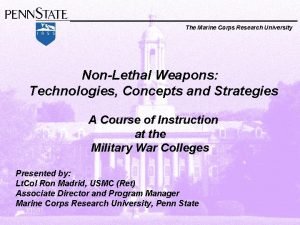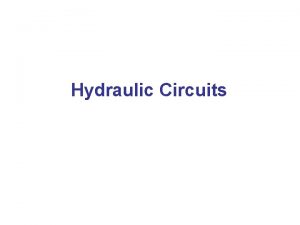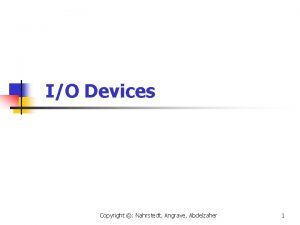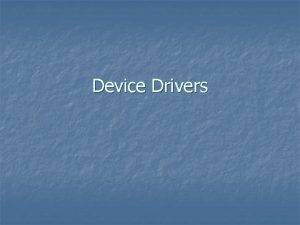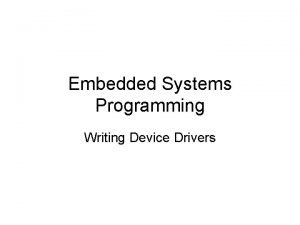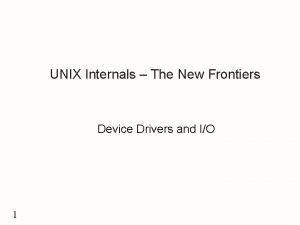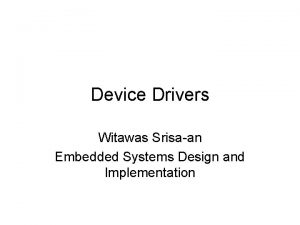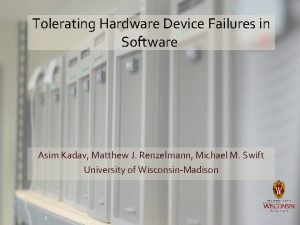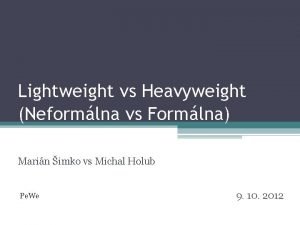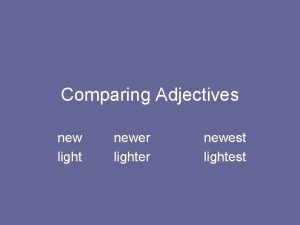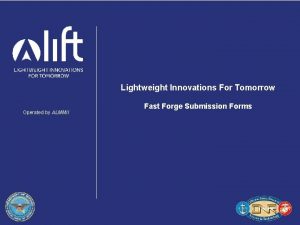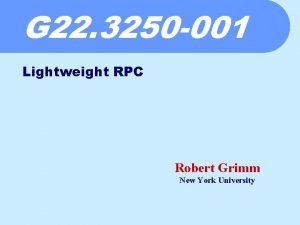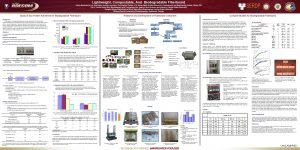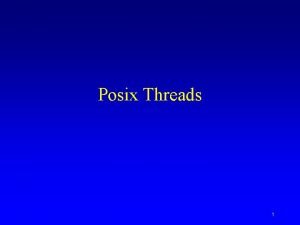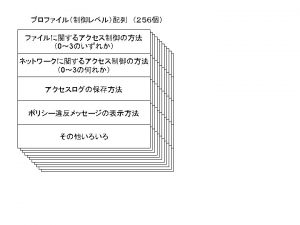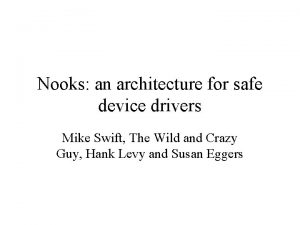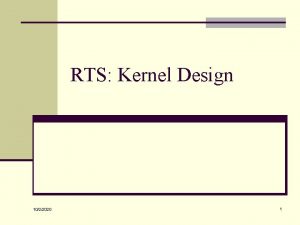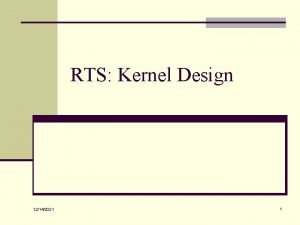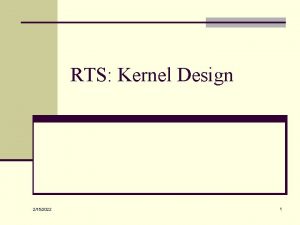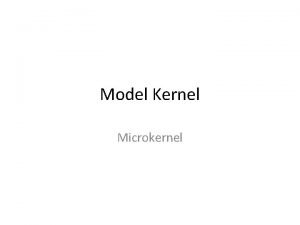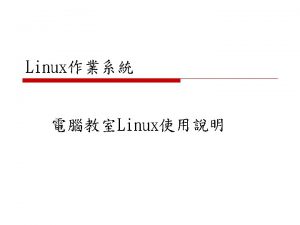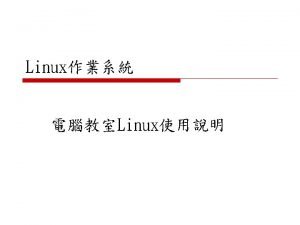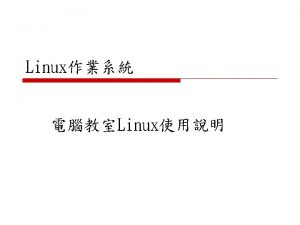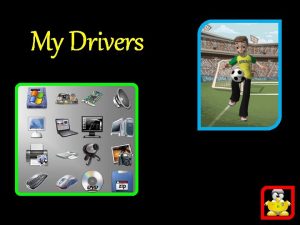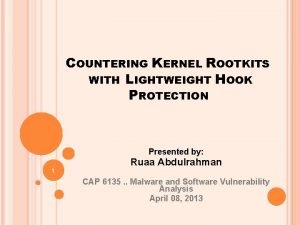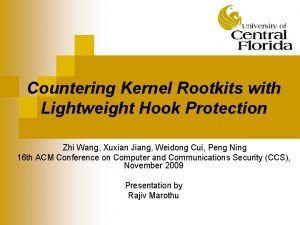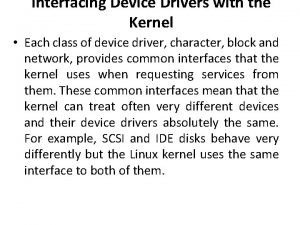Nooks Safe Device Drivers with Lightweight Kernel Protection




















- Slides: 20

Nooks: Safe Device Drivers with Lightweight Kernel Protection Domains Mike Swift, Steve Martin Hank Levy, Susan Eggers, Brian Bershad University of Washington

Device Drivers Limit the Reliability of Operating Systems l Windows 2000: #1 source of reported kernel bugs [Murphy ’ 00] l Windows 2000 Other 3 rd Party Kernel code 11% Linux: 7 x bugs of other kernel code [Chou ’ 01] Drivers for Non. HCL HW 20% System Config 34% Ø Drivers for HCL HW 7% Device drivers are not controlled by OS vendors, yet critically impact the reliability of the system MSInternal. Code 2% Other IFSDrivers 0% Anti-Virus 4% HW Failure 22% Source: Brendan Murphy, Sample from PSS Incidents

What Can We Do? 1. 2. Ø Improve drivers¹ Allow drivers to fail without crashing the kernel² We want an immediate benefit for the thousands of existing drivers and driver developers ¹ [Chou ’ 01, Microsoft ’ 01, Mérillon ’ 99, Golm ’ 02] ² [Forin ’ 91, Hartig ’ 97, Hunt ’ 97, Van Maren ’ 00]

Goals l l Ø Improve OS reliability by tolerating device driver faults Retain compatibility with existing device drivers Solution: Isolate device drivers within a sandbox, retaining the existing API

Outline l l What are the characteristics of the driver environment? Nooks: Lightweight kernel protection domains Initial performance evaluation Conclusion

What makes isolation feasible? l Isolation performance depends on – – Ø Level of isolation required Cost of crossing isolation boundary Cost of moving data across boundary Cost of executing isolated code We need to understand drivers before we can isolate them.

How are drivers special? l Drivers are different than previous extensible execution environments – – – l Drivers already exist Drivers move a lot of data Drivers have only limited application state Reliability is fundamentally different than safety / protection – – 100% isolation unnecessary Drivers are trusted, mostly

Understanding Driver Faults l Most faults are simple – – – l [Chou ’ 01, Linux kernel Bugzilla] Illegal memory access Invalid use of locks Leaving interrupts disabled Faults can be detected by verifying memory accesses and pre/post conditions on driver execution

Understanding the Driver Environment l Large driver / kernel interface in Linux – – l Many optimization opportunities – – l 139 interfaces for loadable code, 669 functions 723 functions in kernel called by drivers Many read-only parameters Large data items are handed off Majority of functions are for initialization/cleanup Many boundary crossings can be avoided Kernels already support stopping, starting, and binding drivers dynamically

Understanding Driver Execution l Only a few kernel functions are called at performance-critical points – – l Majority called during init / cleanup Critical functions can be executed locally or deferred Interrupt handlers take ~20, 000 cycles

Summary l Device drivers are different – – l Device drivers are not malicious Existing code must be supported Device drivers are amenable to isolation – – Few kernel functions need to execute quickly Many boundary crossings can be optimized away Most common faults can be trapped by memory isolation and checks on interfaces Kernels support recovery by unloading / reloading drivers

Nooks: Executing Device Drivers Safely l Goals of Nooks: Limit scope of corruption caused by drivers 2. Recover quickly with no lost application state 3. Require only minimal change to the kernel 4. Require no source changes for most device drivers 1. l Approach: isolate device drivers with virtual memory, retaining existing API

Lightweight Kernel Protection Domains • A lightweight kernel protection domain is a module that: • • Executes in kernel mode Is logically part of the kernel Has read access to kernel data Has restricted write access to kernel data

Implementing LKPD l Memory protection – – l Separate page tables / TLB entries Same address mapping, different protection Wrapped kernel/driver entrypoints – – – Identify protection domain for code Change protection domains / stacks Verify / copy / protect parameters Track resource usage for cleanup / limits Minimize boundary crossings

LKPD benefits • Efficiently supports privileged but unreliable code – – Supports zero-copy parameters Allows re-use of existing kernel code Supports sparse address space Efficiently executes driver code

Nooks Architecture l l l Plugs into existing code with minimal changes Supports multiple drivers / domain for fate sharing Not necessary for all drivers

Initial Evaluation l Implementation – – l Platform – – – l Interface wrappers for resource isolation Trap and TLB flush to emulate protection domains Linux 2. 4. 10 kernel 1. 7 GHz Intel Pentium 4 processor Intel E 1000 Gigabit Ethernet NIC Tests – – SPECweb 99 with Apache 2. 0 Net. Perf

Nooks Performance

Current Status l Implemented separate protection domains Working on lowering privileges, locking & interrupts, additional devices l Many difficult details: l – – – x 86 architecture: hardware TLB, large kernel pages, global pages Linux: inline functions & macros as part of driver API Devices: restricting device-hosted DMA

Conclusions l Drivers limit OS reliability – l Lightweight kernel protection domains support reliable driver execution – – – l Prevents kernel corruption Supports existing driver API Leverages dynamic driver support for recovery Nooks implements this in Linux – l OS must tolerate buggy device drivers Initial performance is promising We are looking for additional applications of LKPD
 Vehicle lightweight arresting device
Vehicle lightweight arresting device Input device output device storage device
Input device output device storage device Series hydraulic circuit
Series hydraulic circuit Safe feed safe food
Safe feed safe food Safe people safe places
Safe people safe places Functions of device drivers
Functions of device drivers Drivers computer definition
Drivers computer definition Writing device drivers for embedded systems
Writing device drivers for embedded systems Unix device drivers
Unix device drivers Designing device drivers for embedded systems
Designing device drivers for embedded systems Ms dos device drivers
Ms dos device drivers Asim kadav
Asim kadav Embolic protection device
Embolic protection device Lightweight vs heavyweight framework
Lightweight vs heavyweight framework Light comparative
Light comparative Almmii
Almmii Lightweight rpc
Lightweight rpc Lightweight fiberboard
Lightweight fiberboard Literal language.
Literal language. Dartmouth lightweight rowing
Dartmouth lightweight rowing Posix threads
Posix threads
